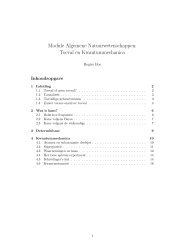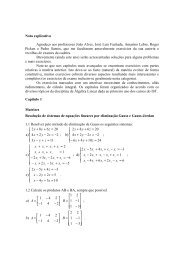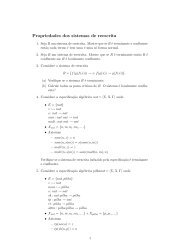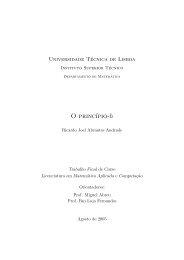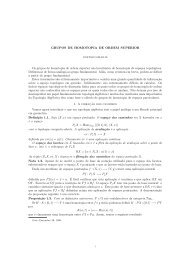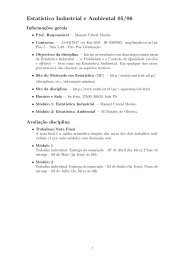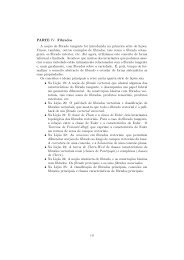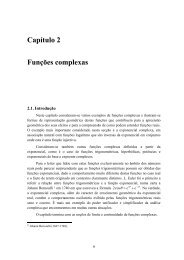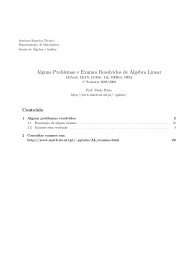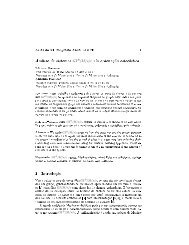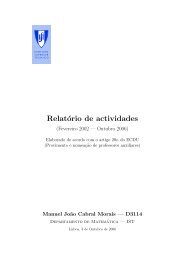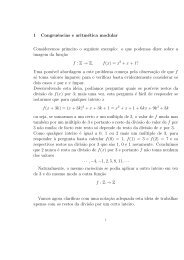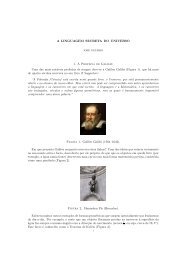- Page 1 and 2: Conteúdo 1 Noções Básicas da Á
- Page 3 and 4: CONTEÚDO 3 8 Álgebra Comutativa 3
- Page 5 and 6: Prefácio A divisão tradicional da
- Page 7 and 8: Prefácio 7 texto. Foi com grande s
- Page 9 and 10: Capítulo 1 Noções Básicas da Á
- Page 11 and 12: 1.1. Introdução 11 as convençõe
- Page 13 and 14: 1.1. Introdução 13 Se a operaçã
- Page 15 and 16: 1.2. Grupos 15 2. (R + , ·) é igu
- Page 17 and 18: 1.2. Grupos 17 1.2.4 (ii) que ˜e =
- Page 19 and 20: 1.2. Grupos 19 5. Sendo (G, ∗) um
- Page 21 and 22: 1.3. Permutações 21 Dada uma perm
- Page 23 and 24: 1.3. Permutações 23 Proposição
- Page 25 and 26: 1.4. Homomorfismos e Isomorfismos 2
- Page 27 and 28: 1.4. Homomorfismos e Isomorfismos 2
- Page 29 and 30: 1.4. Homomorfismos e Isomorfismos 2
- Page 31 and 32: 1.4. Homomorfismos e Isomorfismos 3
- Page 33 and 34: 1.5. Anéis, Domínios Integrais e
- Page 35 and 36: 1.5. Anéis, Domínios Integrais e
- Page 37 and 38: 1.5. Anéis, Domínios Integrais e
- Page 39 and 40: 1.5. Anéis, Domínios Integrais e
- Page 41: 1.6. Homomorfismos e Isomorfismos d
- Page 45 and 46: 1.6. Homomorfismos e Isomorfismos d
- Page 47 and 48: 1.6. Homomorfismos e Isomorfismos d
- Page 49 and 50: 1.7. Os Quaterniões 49 normalmente
- Page 51 and 52: 1.7. Os Quaterniões 51 (como {1, i
- Page 53 and 54: 1.8. Simetrias 53 Proposição 1.8.
- Page 55 and 56: 1.8. Simetrias 55 Demonstração. (
- Page 57 and 58: 1.8. Simetrias 57 ¡ Figura 1.8.3:
- Page 59 and 60: 1.8. Simetrias 59 2. Veremos no Cap
- Page 61 and 62: Capítulo 2 Os Números Inteiros 2.
- Page 63 and 64: 2.1. Axiomática dos Inteiros 63 De
- Page 65 and 66: 2.1. Axiomática dos Inteiros 65 ma
- Page 67 and 68: 2.2. Desigualdades 67 Com estas no
- Page 69 and 70: 2.2. Desigualdades 69 Teorema 2.2.7
- Page 71 and 72: 2.3. Princípio de Indução 71 7.
- Page 73 and 74: 2.3. Princípio de Indução 73 Dei
- Page 75 and 76: 2.3. Princípio de Indução 75 Com
- Page 77 and 78: 2.4. Somatórios e Produtos 77 são
- Page 79 and 80: 2.4. Somatórios e Produtos 79 Demo
- Page 81 and 82: 2.4. Somatórios e Produtos 81 3. M
- Page 83 and 84: 2.5. Factores, Múltiplos e Divisã
- Page 85 and 86: 2.5. Factores, Múltiplos e Divisã
- Page 87 and 88: 2.6. Ideais e o Algoritmo de Euclid
- Page 89 and 90: 2.6. Ideais e o Algoritmo de Euclid
- Page 91 and 92: 2.6. Ideais e o Algoritmo de Euclid
- Page 93 and 94:
2.6. Ideais e o Algoritmo de Euclid
- Page 95 and 96:
2.7. O Teorema Fundamental da Aritm
- Page 97 and 98:
2.7. O Teorema Fundamental da Aritm
- Page 99 and 100:
2.7. O Teorema Fundamental da Aritm
- Page 101 and 102:
2.8. Congruências 101 6. Prove que
- Page 103 and 104:
2.8. Congruências 103 Qualquer int
- Page 105 and 106:
2.8. Congruências 105 De um ponto
- Page 107 and 108:
2.8. Congruências 107 Temos pois u
- Page 109 and 110:
2.8. Congruências 109 um número i
- Page 111 and 112:
2.9. Factorização Prima e Criptog
- Page 113 and 114:
2.9. Factorização Prima e Criptog
- Page 115 and 116:
Capítulo 3 Outros Exemplos de Ané
- Page 117 and 118:
3.1. Os Anéis Zm 2. Se m = 3, a pa
- Page 119 and 120:
3.1. Os Anéis Zm • Os subanéis
- Page 121 and 122:
3.1. Os Anéis Zm Todos os subanéi
- Page 123 and 124:
3.1. Os Anéis Zm • O anel B é s
- Page 125 and 126:
3.1. Os Anéis Zm 10. Qual é o car
- Page 127 and 128:
3.2. Fracções e Números Racionai
- Page 129 and 130:
3.2. Fracções e Números Racionai
- Page 131 and 132:
3.3. Polinómios e Séries de Potê
- Page 133 and 134:
3.3. Polinómios e Séries de Potê
- Page 135 and 136:
3.3. Polinómios e Séries de Potê
- Page 137 and 138:
3.3. Polinómios e Séries de Potê
- Page 139 and 140:
3.4. Funções Polinomiais 139 Defi
- Page 141 and 142:
3.4. Funções Polinomiais 141 a 2.
- Page 143 and 144:
3.5. Divisão de Polinómios 143 (a
- Page 145 and 146:
3.5. Divisão de Polinómios 145
- Page 147 and 148:
3.5. Divisão de Polinómios 147 7.
- Page 149 and 150:
3.5. Divisão de Polinómios 149
- Page 151 and 152:
3.6. Os Ideais de K[x] 151 Como m(x
- Page 153 and 154:
3.6. Os Ideais de K[x] 153 Vimos ac
- Page 155 and 156:
3.7. Divisibilidade e Factorizaçã
- Page 157 and 158:
3.7. Divisibilidade e Factorizaçã
- Page 159 and 160:
3.7. Divisibilidade e Factorizaçã
- Page 161 and 162:
3.7. Divisibilidade e Factorizaçã
- Page 163 and 164:
3.7. Divisibilidade e Factorizaçã
- Page 165 and 166:
3.7. Divisibilidade e Factorizaçã
- Page 167 and 168:
3.8. Factorização em D[x] 167 Dem
- Page 169 and 170:
3.8. Factorização em D[x] 169 Dem
- Page 171 and 172:
Capítulo 4 Quocientes e Isomorfism
- Page 173 and 174:
4.1. Grupos e Relações de Equival
- Page 175 and 176:
4.1. Grupos e Relações de Equival
- Page 177 and 178:
4.1. Grupos e Relações de Equival
- Page 179 and 180:
4.2. Grupos e Anéis Quocientes 179
- Page 181 and 182:
4.2. Grupos e Anéis Quocientes 181
- Page 183 and 184:
4.2. Grupos e Anéis Quocientes 183
- Page 185 and 186:
4.2. Grupos e Anéis Quocientes 185
- Page 187 and 188:
4.3. Números Reais e Complexos 187
- Page 189 and 190:
4.3. Números Reais e Complexos 189
- Page 191 and 192:
4.3. Números Reais e Complexos 191
- Page 193 and 194:
4.4. Isomorfismos Canónicos de Gru
- Page 195 and 196:
4.4. Isomorfismos Canónicos de Gru
- Page 197 and 198:
4.4. Isomorfismos Canónicos de Gru
- Page 199 and 200:
4.4. Isomorfismos Canónicos de Gru
- Page 201 and 202:
4.5. Isomorfismos Canónicos de An
- Page 203 and 204:
4.5. Isomorfismos Canónicos de An
- Page 205 and 206:
4.5. Isomorfismos Canónicos de An
- Page 207 and 208:
4.5. Isomorfismos Canónicos de An
- Page 209 and 210:
4.6. Grupos Livres, Geradores e Rel
- Page 211 and 212:
4.6. Grupos Livres, Geradores e Rel
- Page 213 and 214:
4.6. Grupos Livres, Geradores e Rel
- Page 215 and 216:
4.6. Grupos Livres, Geradores e Rel
- Page 217 and 218:
4.6. Grupos Livres, Geradores e Rel
- Page 219 and 220:
4.6. Grupos Livres, Geradores e Rel
- Page 221 and 222:
4.6. Grupos Livres, Geradores e Rel
- Page 223 and 224:
Capítulo 5 Grupos Finitos 5.1 Grup
- Page 225 and 226:
5.1. Grupos de Transformações 225
- Page 227 and 228:
5.1. Grupos de Transformações 227
- Page 229 and 230:
5.2. Teoremas de Sylow 229 3. Demon
- Page 231 and 232:
5.2. Teoremas de Sylow 231 Demonstr
- Page 233 and 234:
5.2. Teoremas de Sylow 233 superior
- Page 235 and 236:
5.3. Grupos Nilpotentes e Resolúve
- Page 237 and 238:
5.3. Grupos Nilpotentes e Resolúve
- Page 239 and 240:
5.3. Grupos Nilpotentes e Resolúve
- Page 241 and 242:
5.4. Grupos Simples 241 Por outras
- Page 243 and 244:
5.4. Grupos Simples 243 Demonstraç
- Page 245 and 246:
5.5. Grupos de Simetrias 245 5.5 Gr
- Page 247 and 248:
5.5. Grupos de Simetrias 247 {I, ρ
- Page 249 and 250:
5.5. Grupos de Simetrias 249 Demons
- Page 251 and 252:
5.5. Grupos de Simetrias 251 Como H
- Page 253 and 254:
Capítulo 6 Módulos 6.1 Módulos s
- Page 255 and 256:
6.1. Módulos sobre Anéis 255 Defi
- Page 257 and 258:
6.1. Módulos sobre Anéis 257 Se M
- Page 259 and 260:
6.1. Módulos sobre Anéis 259 Prop
- Page 261 and 262:
6.1. Módulos sobre Anéis 261 (b)
- Page 263 and 264:
6.2. Independência Linear 263 Seja
- Page 265 and 266:
6.2. Independência Linear 265 Este
- Page 267 and 268:
6.3. Produtos Tensoriais 267 Propos
- Page 269 and 270:
6.3. Produtos Tensoriais 269 Propos
- Page 271 and 272:
6.3. Produtos Tensoriais 271 Corol
- Page 273 and 274:
6.3. Produtos Tensoriais 273 1. Ver
- Page 275 and 276:
6.4. Módulos sobre Domínios Integ
- Page 277 and 278:
6.4. Módulos sobre Domínios Integ
- Page 279 and 280:
6.4. Módulos sobre Domínios Integ
- Page 281 and 282:
6.5. Módulos de Tipo Finito sobre
- Page 283 and 284:
6.5. Módulos de Tipo Finito sobre
- Page 285 and 286:
6.5. Módulos de Tipo Finito sobre
- Page 287 and 288:
6.5. Módulos de Tipo Finito sobre
- Page 289 and 290:
6.5. Módulos de Tipo Finito sobre
- Page 291 and 292:
6.6. Classificações 291 2. Seja G
- Page 293 and 294:
6.6. Classificações 293 relativam
- Page 295 and 296:
6.7. Categorias e Functores 295 6.7
- Page 297 and 298:
6.7. Categorias e Functores 297 Pro
- Page 299 and 300:
6.7. Categorias e Functores 299 Uma
- Page 301 and 302:
Capítulo 7 Teoria de Galois A solu
- Page 303 and 304:
7.1. Extensões de Corpos 303 A est
- Page 305 and 306:
7.1. Extensões de Corpos 305 A dem
- Page 307 and 308:
7.2. Construções com Régua e Com
- Page 309 and 310:
7.2. Construções com Régua e Com
- Page 311 and 312:
7.3. Extensões de Decomposição 3
- Page 313 and 314:
7.3. Extensões de Decomposição 3
- Page 315 and 316:
7.3. Extensões de Decomposição 3
- Page 317 and 318:
7.4. Homomorfismos de Extensões 31
- Page 319 and 320:
7.4. Homomorfismos de Extensões 31
- Page 321 and 322:
7.5. Separabilidade 321 noção de
- Page 323 and 324:
7.5. Separabilidade 323 Corolário
- Page 325 and 326:
7.6. Grupo de Galois 325 (i) se M
- Page 327 and 328:
7.6. Grupo de Galois 327 logo, não
- Page 329 and 330:
7.7. A Correspondência de Galois 3
- Page 331 and 332:
7.7. A Correspondência de Galois 3
- Page 333 and 334:
7.7. A Correspondência de Galois 3
- Page 335 and 336:
7.7. A Correspondência de Galois 3
- Page 337 and 338:
7.8. Algumas Aplicações 337 A fó
- Page 339 and 340:
7.8. Algumas Aplicações 339 Assim
- Page 341 and 342:
7.8. Algumas Aplicações 341 C z z
- Page 343 and 344:
7.8. Algumas Aplicações 343 Consi
- Page 345 and 346:
7.8. Algumas Aplicações 345 K2 =
- Page 347 and 348:
Capítulo 8 Álgebra Comutativa 8.1
- Page 349 and 350:
8.1. Zeros de Um Polinómio 349 tem
- Page 351 and 352:
8.2. Módulos e Anéis Noetherianos
- Page 353 and 354:
8.2. Módulos e Anéis Noetherianos
- Page 355 and 356:
8.2. Módulos e Anéis Noetherianos
- Page 357 and 358:
8.3. Factorização de Ideais 357 N
- Page 359 and 360:
8.3. Factorização de Ideais 359 4
- Page 361 and 362:
8.3. Factorização de Ideais 361 M
- Page 363 and 364:
8.4. Ideais Maximais e o Lema de Na
- Page 365 and 366:
8.4. Ideais Maximais e o Lema de Na
- Page 367 and 368:
8.5. O Teorema dos Zeros de Hilbert
- Page 369 and 370:
8.5. O Teorema dos Zeros de Hilbert
- Page 371 and 372:
8.5. O Teorema dos Zeros de Hilbert
- Page 373 and 374:
8.6. Divisão de Polinómios 373 p
- Page 375 and 376:
8.6. Divisão de Polinómios 375 Ex
- Page 377 and 378:
8.6. Divisão de Polinómios 377 Na
- Page 379 and 380:
8.7. Bases de Gröbner 379 Definiç
- Page 381 and 382:
8.7. Bases de Gröbner 381 Demonstr
- Page 383 and 384:
8.7. Bases de Gröbner 383 A difere
- Page 385 and 386:
8.7. Bases de Gröbner 385 Exemplo
- Page 387 and 388:
8.7. Bases de Gröbner 387 As bases
- Page 389 and 390:
8.7. Bases de Gröbner 389 12. Em g
- Page 391 and 392:
Apêndice A Complementos sobre a Te
- Page 393 and 394:
A.1. Relações e Funções 393 Exi
- Page 395 and 396:
A.1. Relações e Funções 395 Pro
- Page 397 and 398:
A.2. Axioma da Escolha, Lema de Zor
- Page 399 and 400:
A.2. Axioma da Escolha, Lema de Zor
- Page 401 and 402:
A.2. Axioma da Escolha, Lema de Zor
- Page 403 and 404:
A.2. Axioma da Escolha, Lema de Zor
- Page 405 and 406:
A.3. Conjuntos Finitos 405 Supondo
- Page 407 and 408:
A.3. Conjuntos Finitos 407 De acord
- Page 409 and 410:
A.4. Conjuntos Infinitos 409 10. Pr
- Page 411 and 412:
A.4. Conjuntos Infinitos 411 2. Con
- Page 413 and 414:
A.4. Conjuntos Infinitos 413 É cla
- Page 415 and 416:
A.4. Conjuntos Infinitos 415 (i) |X
- Page 417 and 418:
Sugestões de Leitura Adicional A
- Page 419 and 420:
Sugestões de Leitura Adicional 419
- Page 421 and 422:
Índice Abel, Niels H., 13 Abel-Ruf
- Page 423 and 424:
Sugestões de Leitura Adicional 423
- Page 425 and 426:
Sugestões de Leitura Adicional 425
- Page 427:
Sugestões de Leitura Adicional 427




